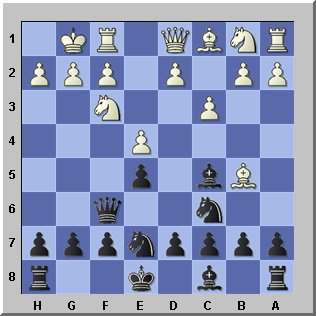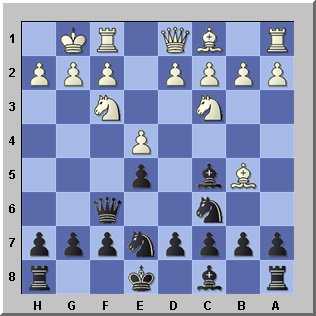This line is easy to learn, very effective and almost nobody knows it. It is not played at top level chess because if White plays the best moves then Black will have a hard time holding the center, because his queen on f6 is exposed and might get chased around.
However, most White players don’t know how to handle it effectively and Black gets a good game.
The chess variation Qf6-Defence is part of the Classical or Cordel Variation. It is never played among chess grandmasters. The reason is probably a general dislike to bring the queen out early in the game, which can’t be a good move.
I tested this variation and like it very much. I find that if White trys to win by force he often runs into a bad position himself and loses.
I tell you a secret. This move is an idea of the Fritz chess program, so Qf6 can’t be a bad move. I played a lot of games in the internet with this opening but couldn’t find a refutation. There is one uncomfortable variation, but when you know how to handle it you should be right.( Study the piece sacrifice in Game 2 move number 9 )
The critical line, which is most uncomfortable for Black, is when White does not castle right away, but saves time and plays 5.d4 right away (instead of 5.0-0).
1.e4 e5 2.Nf3 Nc6 3.Bb5 Bc5 4.c3 Qf6 5.d4 exd4 6.e5 Qe6 7.cxd4 Nxd4!? 8.Nxd4 Qb6 9.Be3 Bxd4 10.Bxd4?! (even better seems to be 10. Qxd4! Qxb5 11.Nc3, I wouldn’t like to have Black here…) The point is when White castles early before he plays d4 then Black has more time and can play Ne7 developing another piece. (example: 5.0-0 Nge7)
Don’t worry! Almost nobody will find this unpleasant line in a real game, many castle and play d4 later. But we can improve on it for Black and play the improved line below.
So don’t play 7…Nxd4? but 7…Bb4+ 8.Nc3 Nge7 9.0-0 d5 10.Bd3 Ba5 (not 10…0-0 because of Bxh7+) 11.Ne2 f6 12.Nf4 Qf7 13.exf Qxf. This chess variation is still a bit better for White but Black can survive I think ….
Memorize this line just in case that White finds and plays the uncomfortable line 1.e4 e5 2.Nf3 Nc6 3.Bb5 Bc5 4.c3 Qf6 5.d4!. If he doesn’t find it then you probably win with a crushing attack at the kingside.
 |
 |
| Basic position with c3 – White to move – I call this the slow setup as White has played a pawn move (c3) and not a piece move (Nc3). This allows you to make the protecting pawn move h6, after White has played d3, to protect your queen from Bg5. |
Basic position with Nc3 – White to move – I call this the fast setup because White has developed the knight to c3 and not played c3 (a pawn move). White will play now d3. In this fast setup (Nc3) you should not play h6 to stop the bishop from attacking your Queen, but the queen goes to d6 instead when attacked by Bg5 (Qd6). The idea behind this is that White has developed a piece (Nc3) and has not played a pawn move (c3), which is slow. So you should develop a piece also, and not make a pawn move (h6) after d3, which is losing valuable development time. So after White has played d3, you castle which is equivalent to a piece move. Qf6 Variation – Fast Setup |
- Play Bb6, if the bishop is attacked by Be3 and keep the position closed until you have castled.
- Watch out for Bg5, attacking your queen and play h6 to stop that, but only if you have to!
- Avoid playing a6 if you are not forced. You need this pawn to protect your Bishop, which goes to b6 very often.
- Don’t trade off your c5-bishop for the white e3-bishop as this will result in a change in the pawn structure. The f-pawn will recapture and move to e3. This will stop your knight from going to the important square f4!
- Don’t play d6 before you have castled or you might lose a piece after the white pawn moves d4 and d5. Castle first then play d6 if you can and complete development.
- Play your knight to g6 and then to f4. This will start a dangerous attack against the white kingside. Study the following games and the typical attacking procedures and memorize them!
Classical-Defence ( Qf6 Variation ) – Chess Games
Flip Board: Press F-Key (or click e7 or d2 on top) Select a game: Click on grey bar
Back to – Chess Openings
Go from – Chess Variation – to – How to play Chess – Home
 Sick of Losing at Chess? Get Chess Courses from a Grandmaster! HUGE Discount! Click here!
Sick of Losing at Chess? Get Chess Courses from a Grandmaster! HUGE Discount! Click here!Get Chess Course -Beginners Package- from a Grandmaster! Huge Discount!
Privacy Policy Impressum/Disclosure Disclaimer Donate
© 2008- www.Expert-Chess-Strategies.com
